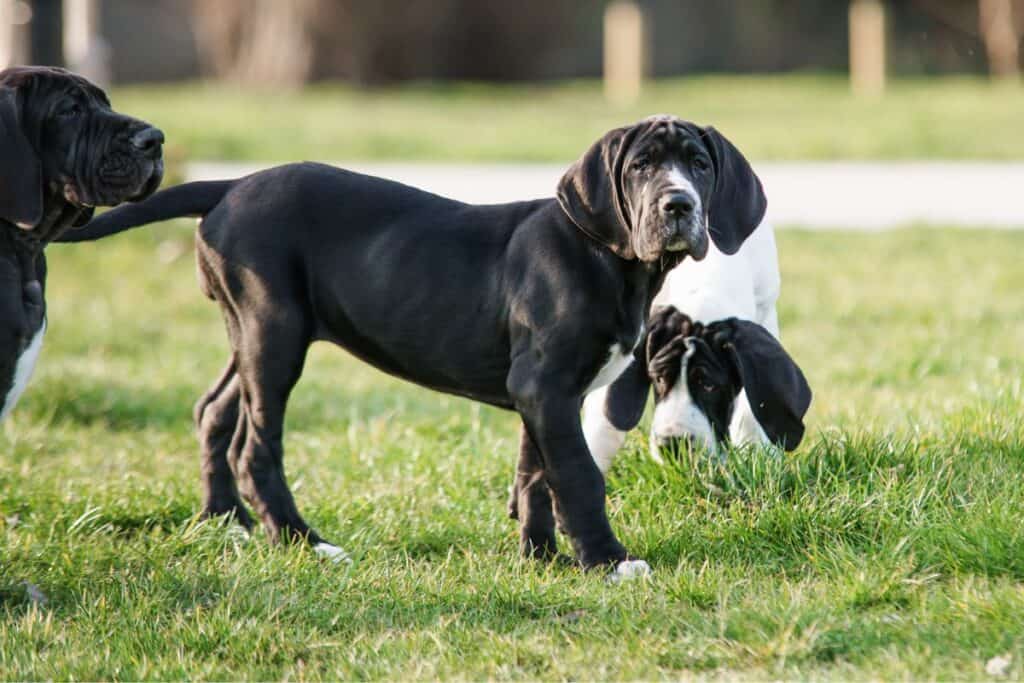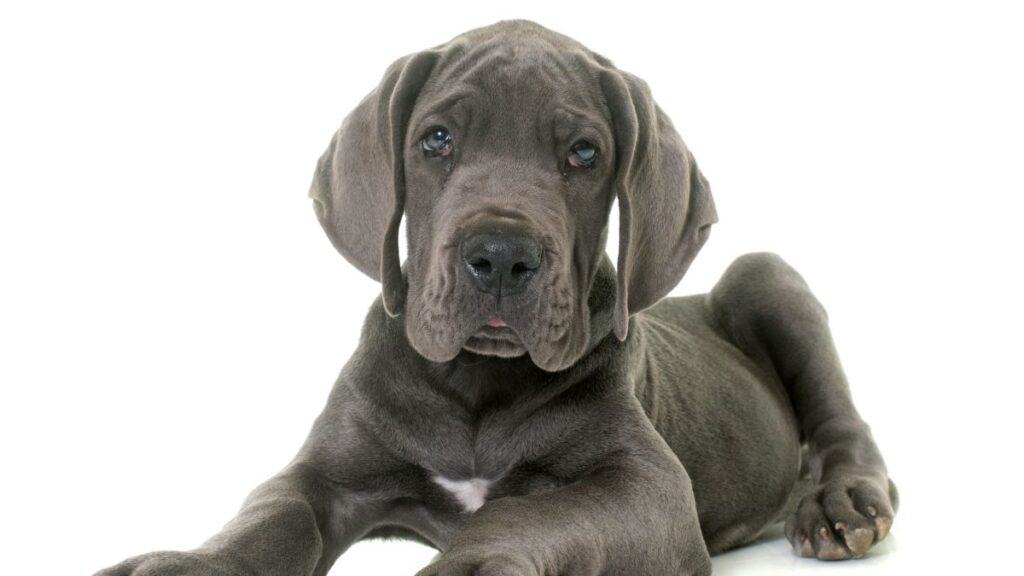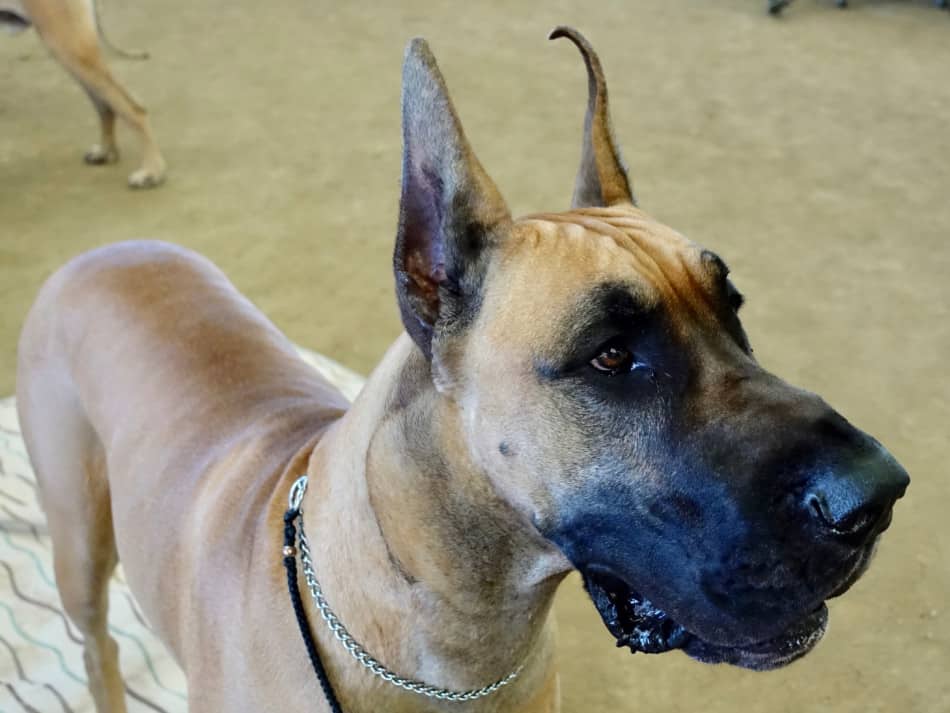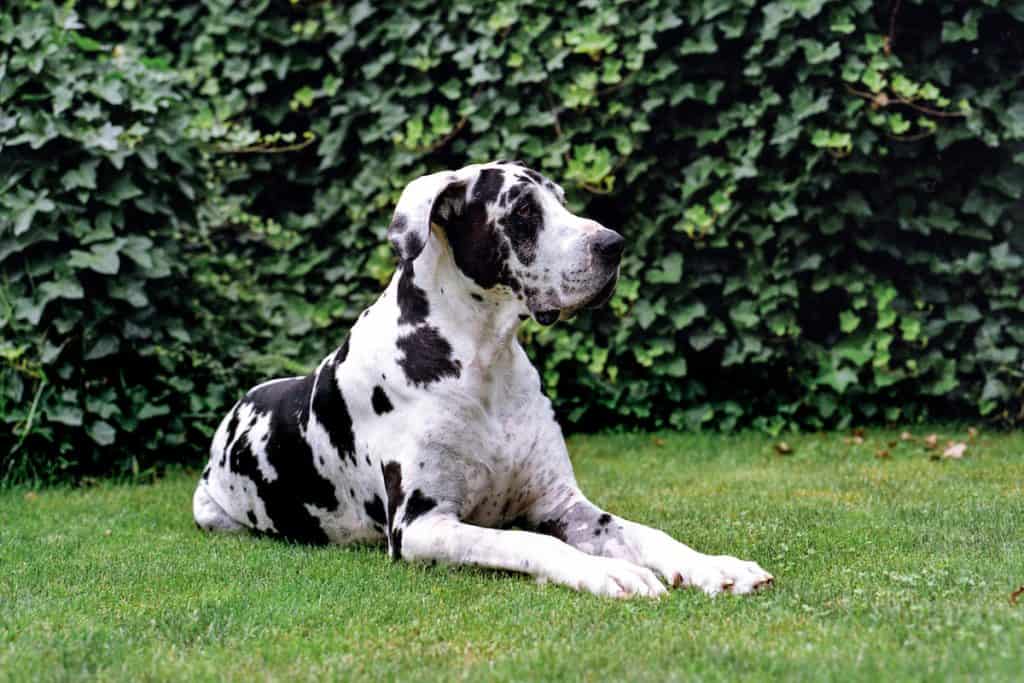
Discover the essentials of raising a Great Dane puppy, a breed cherished for its loyalty and gentle nature. This 101-style guide covers the critical aspects of care, space, exercise, and health to ensure your Great Dane thrives as a beloved family member!
Keep reading to unlock the secrets to a happy, healthy life with your impressive new companion.
Table of Contents
Physical Characteristics
Great Dane dogs are known for their large size and majestic appearance.
They have a number of physical characteristics that make them stand out from other dog breeds.

Size and Weight
Great Danes are one of the largest dog breeds in the world! Even as puppies, their size can be quite impressive.
These puppies are born typically weighing between one and two pounds but grow quickly as they age!
Here’s a quick breakdown of typical height and weight for Great Dane puppies in their first six months.
| Age [months] | Weight [lbs] | Height [inches] |
| 1 | 5 – 8 | — |
| 2 | 15 – 30 | 13 – 18 |
| 3 | 25 – 45 | 17 – 23 |
| 4 | 45 – 65 | 20 – 25 |
| 5 | 60 – 85 | 24 – 30 |
| 6 | 65 – 100 | 26 – 33 |
To learn more about when Great Danes stop growing, take a look at my full article.
As they mature into adults, you can expect a fully-grown Great Dane to fall somewhere into the ranges listed below.
- Males can reach up to 32 inches tall at the shoulder and weigh anywhere from 120 to 200 pounds.
- Females can be slightly smaller, reaching up to 30 inches tall and weighing between 100 to 130 pounds.
They are known for their great size and strength, which can make them intimidating to some people.
Coat and Shedding
Great Danes have a short, smooth coat that is easy to maintain. They come in a variety of colors, including fawn, brindle, black, blue, harlequin, mantle, and merle.
You can learn more about the official Great Dane colors in my full article on the topic.
While they are not heavy shedders, they do shed throughout the year and require regular brushing to keep their coats healthy and shiny.
Once-per-week brushing is enough to control most Great Dane shedding.

Distinct Features
One of the most distinctive features of Great Danes is their large, floppy ears.
They also have a long, narrow head and a deep, broad chest.
Despite their imposing size, they are also known for their gentle and friendly nature. They also make excellent family pets and are especially good with children!
Dog Personality and Temperament
Great Danes are known for their gentle giant personality. They are powerful dogs but also very gentle and affectionate.
They are often referred to as couch potatoes because they love to lounge around with their owners.
Great Danes are known for their sweet and noble temperament despite their size. They are very affectionate and love to be around their family.
They are great with children and other pets and are often referred to as “gentle giants.”
Great Danes are not aggressive dogs but have a powerful presence. They are known for their loyalty and make great guard dogs.
They are also moderately intelligent and often easy to train.
It is important to note that they require a lot of space to exercise. They need plenty of room to move around and play.
Overall, Great Danes have a wonderful personality and temperament. They are loyal and affectionate and make great family pets.
They can be a wonderful addition to any household with proper training and socialization!

Health and Lifespan
Great Danes are adorable and fun to be around, but it’s important to note that they are prone to certain health issues.
Understanding these health issues can help you take better care of your dog and ensure that they live a happy and healthy life.
Common Health Issues
Great Danes are prone to certain medical conditions like bloat, elbow dysplasia, and dilated cardiomyopathy. Bloat is a serious condition that affects many large dog breeds, including Great Danes.
It occurs when the stomach twists on itself, trapping gas and food. This can be a life-threatening condition and requires immediate veterinary attention.
Elbow dysplasia is a common orthopedic condition that affects many large dog breeds. It occurs when the elbow joint doesn’t develop properly, causing pain and lameness.
Dilated cardiomyopathy is a heart condition that affects many large dog breeds, including Great Danes. It occurs when the heart muscle becomes thin and weak, making it difficult for the heart to pump blood effectively.
Lifespan
The average lifespan of a Great Dane is between 7 and 10 years, with some living up to 12 years.
Sadly, some Great Danes may only live 6 or 7 years due to health issues.
It’s important to note that with their giant frames, Great Danes are more likely to develop joint and bone diseases like hip dysplasia and arthritis.
Proper nutrition, exercise, and regular veterinary check-ups can help ensure that your Great Dane lives a long and healthy life.

Food
Puppy-specific food is a staple for many other dog breeds; however, you’ll want to be careful about which puppy food you feed a Great Dane.
Given that these dogs already grow so fast, you actually DON’T want to rush their natural growth pattern as it can lead to growth diseases.
Feeding your Great Dane food meeting specific requirements around micro and macronutrient levels, calories, and containing quality ingredients ensures that they receive the proper nutrition to support proper growth while minimizing the risks.
To learn more about the precise puppy food details, take a look at some of my full articles linked below:
- Can Great Danes Eat Puppy Food?
- When Can Great Dane Puppies Eat Adult Food?
- How Much To Feed A Great Dane Puppy

Training and Exercise
Great Danes are known for their large size and playful nature. Training and exercise are essential for these puppies to grow into well-behaved, healthy adult dogs.
This section will discuss some training tips and their exercise needs.
Training Tips
Great Dane puppies are intelligent and easy to train. However, they can be stubborn at times, so it is essential to start training them as early as possible.
Socialization is critical during the first few months of a dog’s life. They should be introduced to as many healthy people, dogs, and other animals as possible.
This will help them develop their social skills and become well-adjusted adult dogs.
Positive reinforcement is the best way to train a Great Dane.
This means rewarding them with treats, praise, and playtime when they do something right. Punishing them for bad behavior is not recommended, as it can lead to fear and aggression.
When training a Great Dane, it is essential to be patient and consistent. Short training sessions of 10-15 minutes a day are recommended. This will prevent them from becoming bored or overwhelmed.
Exercise Requirements
Puppies are energetic and require plenty of exercise to stay healthy and happy. However, they should not be over-exercised as this can lead to joint problems later in life.
Multiple short walks per day are recommended for young Great Danes. This will help them burn off excess energy and keep them physically fit!
In addition to walking, they should be given plenty of opportunities to play and run around. A large, fenced yard is ideal for this purpose. However, if a yard is not available, a trip to the local dog park or a game of fetch in a safe, open area will suffice.
It is essential to monitor a Great Dane’s exercise routine and adjust it as necessary. If they seem tired or lethargic, it may be time to cut back on their exercise.
On the other hand, if they seem restless or hyperactive, they may need more exercise.

Grooming Needs
Great Danes have a short, smooth coat that requires minimal grooming.
However, regular grooming is still necessary to maintain their hygiene and keep them looking their best.
Here are some grooming needs to keep in mind when caring for a Great Dane.
Bathing
Great Danes should be bathed every 6-8 weeks or as needed.
Use a mild, dog-specific shampoo and conditioner to avoid drying out their skin.
It is important to rinse your puppy thoroughly to avoid any residue left behind, which can cause skin irritation.
Brushing
They do not require daily brushing, but brushing them once a week is a good idea to minimize shedding and keep their coat healthy.
It also helps contain any Great Dane shedding and helps keep your home cleaner!
Use a soft-bristled brush to avoid damaging their skin.
Nail Trimming
Puppies have fast-growing nails that require regular trimming.
Neglecting to keep their nails trimmed can lead to discomfort, pain, and even difficulty walking.
Trim their nails every 2-3 weeks or as needed, using a sharp, guillotine-style
For more tips on this topic, make sure to look at my dedicated article on how to trim a Great Dane’s nails.
Ear Cleaning
Great Danes have floppy ears that can trap dirt and moisture, leading to ear infections.
Clean their ears once a week using a dog-specific ear cleaner, cotton balls, and a soft cloth. Be gentle and avoid inserting anything into their ear canal.
You can find my dedicated guide on Great Dane ear cleaning here.
Dental Care
Great Dane pups can experience dental problems, so it is important to establish a dental care routine early on!
Brush their teeth daily using a dog-specific toothbrush and toothpaste.
You can also provide dental chews and toys to help keep their teeth clean.
Grooming a Great Dane is relatively easy but requires consistency and attention to detail. Establishing a regular dental routine can help keep your puppy healthy, happy, and looking their best!
For more tips on keeping teeth healthy, take a look at my full article on Great Dane teeth care.

Buying a Great Dane & Adoption
If you’re considering buying a Great Dane dog, you should know a few things to ensure you locate a reputable breeder and a healthy dog.
It’s also important to point out that you can also discover Dane puppies at local shelters for adoption. So make sure to take a look there as well!
This section will cover finding a breeder and the price range you can expect to pay for a Great Dane.
Finding a Breeder
When looking for a Great Dane breeder, it’s important to do your research to ensure you find a reputable breeder. Organizations like the Great Dane Club of America are a great starting point for many.
Tip: The Great Dane Club of America maintains a list, and I’ve also got one in my article “Great Dane Breeders Near Me“.
Once you’ve found a breeder, be sure to ask plenty of questions about the puppies and their parents. A good breeder will be knowledgeable about the breed and be able to answer any questions you have.
They should also provide you with health certificates for the puppies and their parents and any other relevant paperwork.
Price Range
The price range for Great Danes can vary greatly depending on the breeder and location. On average, you can expect to pay anywhere from $1,500 to $3,000 for a Great Dane dog.
However, some breeders may charge more for puppies with certain colors or markings.
It’s important to remember that the initial cost of a puppy is just the beginning. Great Danes are a large breed and require a lot of food, which can quickly add up on its own!
They also require regular veterinary care, including vaccinations, check-ups, and preventative treatments for parasites.
In conclusion, buying a Great Dane requires careful consideration and research to ensure you find a reputable breeder and a healthy puppy.
By finding the right breeder and understanding the costs associated with owning a Great Dane, you can ensure a happy and healthy life for your new furry friend!

Great Dane Puppy FAQs
WHAT IS THE AVERAGE LIFESPAN OF A GREAT DANE?
Great Danes have an average lifespan of 7-10 years. However, with proper care and regular veterinary check-ups, some have been known to live up to several years longer!
HOW MUCH SHOULD I EXPECT TO PAY FOR A DANE?
The price of a Great Dane can vary depending on the breeder, location, and bloodline. On average, they can cost anywhere from $1,000 to $3,000.
However, it is important to note that the cost of purchasing a Great Dane is just the beginning. They are a large breed and require a lot of food, veterinary care, and other expenses.
ARE DANE Puppies GOOD FOR FAMILIES?
Great Danes can make great family pets. They are known for their gentle and affectionate nature and are great with children.
However, it is important to note that they are a large breed and may not be suitable for families with minimal living space.
WHAT ARE SOME COMMON HEALTH ISSUES FOR GREAT DANEs?
Great Danes are prone to several health issues, including hip dysplasia, bloat, and heart disease. It is important to purchase a Great Dane puppy from a reputable breeder who screens their breeding dogs for these health issues.
WHAT IS THE SIZE AND WEIGHT RANGE FOR DANEs?
Great Danes are born weighing between 1-2 pounds and typically grow to 65-100 pounds in weight and 26 – 33 inches in height by the time they are six months old.

These articles are so great,I learn so much.thank you.